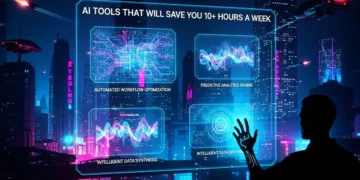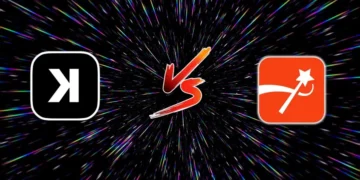When you look up at the night sky, do you ever wonder how we’re able to explore such incomprehensible vastness? The answer increasingly lies not just in human courage and curiosity, but in artificial intelligence in space systems working tirelessly behind the scenes. Artificial intelligence has quietly revolutionized how we venture beyond our planet, transforming from a supporting tool to an indispensable partner in cosmic discovery.
Imagine a spacecraft making critical navigation decisions millions of miles from Earth, a rover selecting its own path across alien terrain, or a satellite network predicting its own maintenance needs—this is no longer science fiction. In 2025, AI in space exploration represents one of the most significant technological convergences of our time, with global investments surging by 187% since 2021 to reach $12.8 billion according to Space Analytics Institute .
From NASA’s Mars rovers autonomously navigating the Red Planet to machine learning algorithms sifting through terabytes of astronomical data to find distant exoplanets, AI is addressing challenges that were once insurmountable. These technologies are not merely enhancing existing processes; they’re enabling entirely new capabilities that expand our understanding of the universe and humanity’s place within it. As we stand at the precipice of interplanetary colonization, the partnership between human ingenuity and artificial intelligence may well determine the success of our cosmic ambitions.
How AI is Revolutionizing Spacecraft Operations
Autonomous Navigation and Real-Time Decision Making
The vast distances of space create communication delays that make real-time control from Earth impossible for distant missions. This limitation has catalyzed one of AI’s most valuable applications: enabling spacecraft to think for themselves. Advanced AI systems now allow probes and landers to make critical navigational decisions independently, adjusting to unexpected obstacles and opportunities without waiting for instructions from ground control that might take hours or days to arrive.
Consider the challenge of navigating through an asteroid field or landing on an unpredictable planetary surface. Traditional approaches would require painstaking human analysis and command sequences transmitted across millions of miles. Today, AI-powered navigation systems can process sensor data in real-time to identify hazards, calculate optimal trajectories, and execute precise maneuvers—all without human intervention. The Perseverance rover’s autonomous navigation capabilities allow it to travel up to 120 meters per day across challenging Martian terrain without direct human guidance .
These systems employ sophisticated machine learning algorithms that continuously improve their performance based on experience. Portal Space Systems is developing advanced mobility platforms with Pentagon backing, while companies like Starfish Space are testing autonomous orbital docking systems . The implications are profound: spacecraft that can adapt to unexpected conditions, seize scientific opportunities, and ensure mission safety even when cut off from Earth-based control.
Predictive Maintenance and System Self-Monitoring
For long-duration missions where repair or replacement simply isn’t an option, preventing failures before they occur becomes paramount. This is where AI’s predictive capabilities are transforming spacecraft design and operation. AI-driven diagnostic systems like Stellar HealthTech’s AstroVigil analyze data from spacecraft sensors in real-time, predicting potential system failures and recommending preventive measures that onboard systems or astronauts can implement .
The results speak for themselves: implementations have demonstrated a 50% decrease in unscheduled maintenance activities and a marked improvement in mission safety and reliability . Similarly, startup Rebel Space is developing systems that generate synthetic data to predict potential component failures long before launch, potentially preventing “massive mission failure in the future” according to CEO Carrie Marshall .
Table: AI Applications in Spacecraft Operations
| Application Area | Key Function | Real-World Example |
|---|---|---|
| Autonomous Navigation | Real-time obstacle avoidance and path planning | Perseverance rover traveling 120m/day autonomously |
| Predictive Maintenance | Forecasting system failures before they occur | 50% reduction in unscheduled maintenance |
| Resource Optimization | Managing power, fuel, and communication bandwidth | AI calculating most efficient trajectories |
| Fault Management | Self-diagnosis and automated recovery | AstroVigil’s decision-support capabilities |
What if your car could not only tell you when it needed repairs but could actually perform those repairs itself? That’s the level of autonomy AI systems are bringing to space missions, ensuring that spacecraft remain operational and productive throughout their intended lifetimes, even when millions of miles from the nearest human technician.
The New Frontier: Why AI is Indispensable for Modern Space Missions
The sheer volume of data generated by modern space missions is staggering. The Hubble and James Webb telescopes, planetary orbiters, and surface rovers transmit petabytes of information back to Earth. Sifting through this cosmic haystack for the needle of a groundbreaking discovery is beyond human capacity. This is where AI delivers its first massive win. By leveraging data analysis in space with AI, scientists can identify patterns, anomalies, and objects of interest with unprecedented speed and accuracy.
This leads directly to a critical business metric: optimizing space mission ROI with AI. Every space mission is a multi-billion dollar investment. By using AI to automate processes, enhance safety, and increase the probability of mission success, agencies like NASA and ESA are ensuring a higher return on their investment. This isn’t just about saving money; it’s about making every mission count, pushing the frontiers of knowledge further and faster than ever before. Think of it as the ultimate performance marketing campaign, where the conversion goal is a new discovery or a safe landing on another world.
Transforming Data Analysis and Scientific Discovery
Processing the Firehose of Space Data
The volume of data generated by modern space missions is staggering—NASA alone processes over 24 terabytes of space-derived data daily . Without AI and machine learning, much of this information would remain unanalyzed, with hidden patterns and discoveries lost in the deluge. AI algorithms are now essential for sifting through this data, identifying significant findings that would escape human notice due to sheer volume alone.
Image processing represents one of AI’s most productive applications. Telescopes and spacecraft capture millions of images of celestial bodies, planetary surfaces, and cosmic phenomena. AI systems can analyze these images far more quickly and comprehensively than human researchers, identifying subtle features and changes that merit further investigation. The European Space Agency’s Gaia mission employs AI to create detailed 3D maps of our galaxy, cataloging and classifying billions of stars while identifying stellar anomalies worthy of further study .
These capabilities extend beyond simple classification. Machine learning algorithms can identify complex patterns in exoplanet atmospheres that might indicate habitability, detect faint radio signals from deep space that could signify interesting astronomical phenomena, and create sophisticated predictive models of planetary formations and cosmic events. At NASA’s Jet Propulsion Laboratory, AI systems on the Perseverance rover have identified 73% more scientifically significant features than human operators alone would have discovered in the same timeframe .
Revolutionizing Satellite Operations and Earth Observation
The satellite revolution has created new data challenges and opportunities. Companies like SpaceX and OneWeb use AI to manage complex orbital choreography for thousands of satellites, optimizing global communication coverage while predicting and avoiding potential collision scenarios . This orbital management would be impossible without advanced AI systems coordinating the movements of these satellite constellations.
Meanwhile, Earth observation has been transformed by AI’s ability to interpret satellite data. Systems like Planet Labs AI Imagery Platform process satellite images in near real-time, automatically detecting phenomena like wildfires, deforestation, and infrastructure changes . This capability has profound implications for climate monitoring, disaster response, and urban planning.
Table: AI Tools for Space Data Analysis
| Tool Name | Primary Function | Key Features |
|---|---|---|
| NASA’s ExoMiner | Exoplanet discovery | AI-driven planet detection from Kepler/TESS data |
| Google DeepMind AstroSim | Astrophysics simulation | Dark matter and galaxy formation modeling |
| Planet Labs AI Platform | Earth observation imagery | Automated object detection and multi-spectral analysis |
| IBM Watson Space Analytics | Mission data analysis | Predictive analytics for spacecraft health |
Have you ever struggled to find a specific photo in a massive unorganized collection? That’s the challenge astronomers face with cosmic imagery—but on a scale of billions of images. AI in space exploration is solving this problem, acting as an indefatigable research assistant that never sleeps, never gets bored, and consistently identifies the most intriguing needles in the cosmic haystack.
AI in Action: Case Studies from Current Missions
Mars Rovers: Planetary Exploration Autonomy
The Mars rovers represent some of the most visible and impressive applications of AI in space exploration. NASA’s Perseverance and Curiosity rovers employ multiple AI systems that enable them to operate with unprecedented independence on another world. These robotic explorers use autonomous navigation across challenging Martian terrain, with Perseverance capable of traveling significant distances without human intervention .
But the autonomy extends beyond mere movement. The rovers use AI-powered spectroscopic analysis to select scientifically valuable soil and rock samples—a crucial capability given the limited number of samples that can be collected and the high cost of returning them to Earth. These systems also prioritize data transmission back to Earth, processing over 30GB of raw data before compression to ensure the most valuable information gets bandwidth priority .
The results have been transformative. NASA reports that AI systems have reduced Earth-based decision-making time by 62% compared to previous rover missions . This efficiency gain means that the rovers can respond more quickly to new discoveries, adapt to changing environmental conditions, and maximize their scientific output during their operational lifetimes. The success of these systems provides a blueprint for future missions to even more distant worlds where communication delays make real-time control impossible.
Lunar Exploration and Future Colonization
As humanity returns to the Moon with ambitions of permanent settlement, AI is playing an increasingly crucial role. Blue Origin’s Blue Moon Mark 1 lander, scheduled for an uncrewed demonstration mission next year as part of NASA’s Artemis program, will showcase advanced AI landing capabilities . These systems enable precise touchdown in challenging lunar terrain, avoiding hazards that could jeopardize missions.
Looking further ahead, companies are developing AI-driven resource utilization systems that could prove essential for sustainable lunar presence. Blue Origin’s Blue Alchemist project aims to extract materials from moon dirt, turning them into solar cells, construction materials, and oxygen for lunar settlements . Similarly, startup Interlune is developing AI systems to identify and extract valuable resources like helium-3 from lunar soil .
These applications demonstrate how AI in space exploration is evolving from a support tool to a fundamental enabler of long-term human presence beyond Earth. The technologies being developed today will likely form the foundation of future extraterrestrial economies, allowing humans to “live off the land” rather than depending entirely on supplies from Earth.
Deep Space Communication and Coordination
The challenges of deep space communication represent another area where AI is making significant contributions. CosmicLink Solutions has developed DeepSpaceNet, an AI-driven system designed to optimize space communications by dynamically adjusting signal transmission paths based on planetary alignments and solar interference . The system employs machine learning models that predict optimal communication windows and adjust bandwidth allocation based on operational priorities.
The performance improvements are substantial: CosmicLink reports a 50% improvement in signal fidelity and a 30% increase in data transmission rates across all supported missions . These enhancements enable more timely and accurate data retrieval from spacecraft, facilitating real-time scientific analysis and quicker response times to operational anomalies.
What would it be like if your video calls never dropped, your downloads were always at maximum speed, and your devices automatically found the best connections? That’s what AI is bringing to space communications—except across millions of miles of interplanetary space, where signals can take hours to travel at the speed of light.
Emerging Trends and Future Applications
In-Space Data Processing and Edge Computing
One of the most significant limitations of space exploration has been the communications bottleneck—the difficulty of transmitting vast amounts of data back to Earth. Edge computing in space represents a revolutionary approach to this challenge, processing data directly on spacecraft rather than transmitting everything to Earth. According to European Space Agency research, this approach can reduce communication bottlenecks by up to 85% .
The International Space Station’s HPE Spaceborne Computer-2, deployed in 2021, has demonstrated AI processing capabilities 30 times faster than previous space-based computing systems, with a remarkable 97.5% uptime despite radiation and microgravity challenges . Meanwhile, SpaceX’s latest satellite constellation incorporates edge AI processing in each unit, creating a distributed computing network exceeding 1.5 petaflops across the system .
These capabilities enable faster decision-making with response times improving from hours to milliseconds—a crucial advancement for missions where rapid response to changing conditions can mean the difference between success and failure. Companies like Matter Intelligence are leveraging this approach to winnow through geospatial data collected by space sensors while still on the spacecraft, producing analytics products directly instead of downlinking hundreds of gigabytes of raw data .
AI-Driven Resource Utilization and Space Manufacturing
As we look toward establishing a permanent human presence in space, the ability to utilize local resources becomes increasingly important. AI is playing a crucial role in identifying and processing these resources, from lunar ice deposits to asteroid minerals. AstroForge AI Prospect is designed specifically for asteroid mining missions, using AI analysis of asteroid composition and predictive modeling for mining viability .
The potential economic implications are substantial. Interlune envisions “a fleet of five electric harvesters on the moon in the 2030s that’ll extract helium-3 gas and bring it back to Earth” for use in quantum computing and nuclear fusion applications . Similarly, reports suggest SpaceX is working on a project known as Starfall, which would use Starship as a platform for in-space drug research and product development .
These applications demonstrate how AI in space exploration is expanding from scientific research to commercial enterprise, creating the foundation for a space-based economy that could eventually become self-sustaining. The companies developing these capabilities today may well become the industrial giants of tomorrow’s spacefaring civilization.
Challenges and Implementation Considerations
Technical Limitations and Solutions
Despite its impressive capabilities, implementing AI in space exploration faces significant technical challenges that must be addressed. The space environment presents unique obstacles, including radiation that can damage sensitive electronics, extreme temperature variations, and the need for systems to operate autonomously for years without maintenance or repair.
Radiation hardening of AI hardware represents a particular challenge, as traditional machine learning systems are not designed to withstand the high-radiation environment of space . Additionally, operating with limited computational resources requires efficient algorithms that can deliver maximum performance with minimal power consumption and processing requirements—a stark contrast to Earth-based AI systems that can leverage cloud computing and virtually unlimited power.
Companies are addressing these challenges through specialized hardware and software approaches. The emergence of radiation-tolerant processors, low-power AI chips, and federated learning approaches that distribute processing across multiple systems are all helping to overcome these limitations. Edge computing platforms like HPE Spaceborne Computer-2 demonstrate that commercial off-the-shelf technology can be adapted for space use with proper hardening and redundancy .
Ethical and Safety Considerations
As AI takes on more critical roles in space missions, important ethical and safety questions emerge. The militarization of space-based AI raises concerns about autonomous weapons systems operating beyond Earth’s atmosphere . Similarly, equitable access to space resources becomes increasingly important as extraction technologies mature .
Perhaps most fundamentally, as AI systems become more autonomous, we must consider how to ensure they remain aligned with human values and priorities—especially when operating independently millions of miles from Earth. The question of how much autonomy to grant AI systems becomes particularly acute for missions where communication delays make real-time human control impossible.
These considerations are not merely theoretical. As AI in space exploration evolves from performing specific tasks to managing overall mission strategy, we must develop frameworks to ensure these systems remain trustworthy, transparent, and accountable. The space industry is beginning to address these challenges through standardized testing, verification methodologies, and international agreements, but much work remains.
Navigating the Cosmos: AI for Autonomous Spacecraft and Rovers
Perhaps the most compelling application of AI is in autonomous navigation for rovers and other vehicles. When a rover is on Mars, direct remote control is impossible. A command from Earth can take up to 22 minutes to arrive, by which time the rover could have driven into a crater. This is why AI for autonomous spacecraft and rovers isn’t a luxury; it’s a necessity.
NASA’s Mars rovers, Curiosity and Perseverance, are prime examples of this technology in action. They are not just remote-controlled cars; they are robotic field geologists. Using a suite of AI-powered tools, they can:
Perceive their environment: Using stereo cameras, they build 3D maps of the terrain in front of them.
Identify hazards: AI algorithms analyze the map to identify impassable rocks, steep slopes, and sand traps.
Plan their own routes: The AI, known as AutoNav, autonomously selects the safest and most efficient path to its next objective, driving itself for hundreds of meters without a single command from Earth.
Identify scientific targets: A system called AEGIS (Autonomous Exploration for Gathering Increased Science) allows the rover to spot interesting rock formations and autonomously fire its laser to analyze their chemical composition.
Can you imagine building a system so reliable that you trust it to drive itself across another planet? That’s the level of engagement and precision AI brings to the table.
The Brains of the Operation: Machine Learning and Neural Networks
Driving this autonomy are two key AI disciplines: machine learning in space exploration and neural networks for space applications. Instead of being explicitly programmed for every possible contingency, these systems learn and adapt.
Machine Learning (ML) algorithms allow a rover to improve its performance over time. By analyzing the outcomes of its past decisions (e.g., “this type of terrain caused my wheels to slip”), it learns to make better, safer choices in the future.
Neural Networks, inspired by the structure of the human brain, are particularly adept at image recognition. They are the technology that allows the rover to look at a patch of ground and classify it as “safe bedrock,” “hazardous sand,” or “scientifically interesting mineral deposit”. The European Space Agency (ESA) has been actively developing deep learning algorithms to improve image quality and detect features on Earth’s surface from orbit.
The Ultimate Mission Control: AI for Mission Planning and Management
Behind every successful rover traverse and satellite deployment is a mountain of logistical work. AI for mission planning is revolutionizing this behind-the-scenes effort, turning it from a manual, painstaking process into a highly optimized, automated one. AI systems can analyze billions of possible trajectories, launch windows, and mission timelines to find the optimal solution that maximizes scientific return while minimizing fuel consumption and risk.
The logistical complexity is immense, involving resource management, scheduling, and real-time adaptation to unforeseen events. This level of optimization is reminiscent of the sophisticated logistics platforms we see on Earth. Just as a service like Doobie Delivery has mastered the art of using algorithms for real-time tracking, route optimization, and predicting demand to ensure your package arrives efficiently, AI for mission planning coordinates celestial deliveries on a planetary scale. It’s about getting the right assets to the right place at the right time, whether it’s a cannabis delivery in Toronto or a scientific instrument package on Mars.
A New Vision: AI in Satellite Technology and Earth Observation
While deep space missions capture the imagination, much of the AI revolution is happening right above our heads. AI in satellite technology is transforming how we monitor our own planet. Satellites are now equipped with onboard AI that can process images as they are captured. This is called “edge computing,” and it means that instead of sending massive, raw data files back to Earth, the satellite can send just the important information.
This has profound implications for AI in Earth observation. For example:
Disaster Response: An AI-powered satellite can detect the first signs of a wildfire or a flood and automatically alert emergency services in real-time, without waiting for a human analyst to review the images.
Environmental Monitoring: AI algorithms can track deforestation, monitor the health of polar ice caps, and even identify plastic pollution in the oceans by analyzing satellite imagery.
Precision Agriculture: Farmers can use AI-analyzed satellite data to monitor crop health, optimize irrigation, and increase yields.
Cleaning Up Our Cosmic Backyard: AI for Space Debris Solutions
Over 60 years of space activity have left a dangerous legacy: hundreds of thousands of pieces of space junk orbiting Earth at hypersonic speeds. A single stray bolt can destroy a multi-billion dollar satellite. AI for space debris solutions offers a glimmer of hope. Ground-based and space-based sensors can use AI to track thousands of debris objects, predict their trajectories with high accuracy, and calculate collision risks. In the future, AI will guide autonomous “garbage truck” satellites to hunt down, capture, and de-orbit the most dangerous pieces of debris, making space a safer environment for everyone.
The Robotic Revolution: Enhancing Robotic Missions with AI
The future of space exploration is deeply intertwined with robotics. We are moving beyond simple robotic arms to fully autonomous systems. Robotic missions and AI are enabling us to tackle tasks that are too dangerous or too complex for astronauts. The field of AI in space robotics is exploding with possibilities, including:
In-Orbit Servicing: AI-guided robots will be able to autonomously inspect, refuel, and repair satellites, extending their operational lifespan and saving billions of dollars.
Resource Extraction: For future settlements on the Moon or Mars to be sustainable, they will need to use local resources. AI-powered robots will be tasked with prospecting for water ice, mining minerals, and processing them into usable materials like fuel and oxygen.
Habitat Construction: Swarms of autonomous construction robots could 3D-print habitats and infrastructure from local materials before the first human settlers even arrive.
The Digital Astronaut: AI in Astronaut Assistance and Communication
On long-duration missions to Mars or beyond, astronauts will face extreme isolation and communication delays that make real-time support from Earth impossible. This is where AI in astronaut assistance will become a critical crewmate. An onboard AI could:
Serve as an intelligent assistant: Answering complex technical questions, guiding astronauts through scientific experiments, and providing reminders for critical tasks.
Monitor health: Using sensors to track vital signs, sleep patterns, and stress levels, the AI could provide early warnings of health issues and suggest countermeasures.
Provide psychological support: An AI with advanced natural language processing could act as a companion, engaging in conversation and helping to mitigate the psychological strain of deep space travel.
Furthermore, cognitive radio communication powered by AI will be essential. This technology allows a spacecraft’s communication system to intelligently scan the radio spectrum, identify the clearest and most efficient frequencies, and automatically switch between them to maintain a stable link with Earth, even through interference.
Unveiling Secrets of the Universe: AI-Driven Discoveries and Asteroid Detection
The ultimate goal of space exploration is discovery. AI-driven discoveries in space are already happening, as algorithms pore over data from missions like Kepler and TESS, identifying exoplanets that human analysts missed. AI is also being used to analyze the light from distant stars and galaxies to understand their chemical composition and evolution.
Closer to home, AI plays a vital role in planetary defense. AI for asteroid detection systems scan telescope images, identifying and tracking near-Earth objects. By analyzing their orbits, AI can predict if an asteroid poses a threat to Earth, giving us the precious time needed to plan a deflection mission.
The Future of AI in Space Missions: A Look Ahead
The integration of AI is still in its early stages, but the trajectory is clear. The future of AI in space missions points towards even greater autonomy and capability. We can anticipate:
AI Hive Minds: Swarms of small, inexpensive spacecraft or robots that work together collaboratively, sharing information and learning as a collective, much like an ant colony. If one robot learns a better way to navigate, the entire swarm learns instantly.
Fully Autonomous Science Campaigns: A mission could be sent to explore the moons of Jupiter with a high-level objective like “Find signs of life in the oceans of Europa.” The AI would then plan its own experiments, collect and analyze data, and decide what to do next without any human intervention.
Interstellar Probes: For any realistic mission to another star system, which would take decades or even centuries, AI is the only option. The spacecraft would need to be completely self-sufficient, able to navigate, repair itself, and make all its own decisions for the entire duration of the journey.
This journey is not just a technical one; it’s reshaping how we explore. For more insights into the pioneering work being done, resources from authoritative bodies like the European Space Agency (ESA) are invaluable.
Conclusion
Artificial intelligence in space exploration has evolved from a theoretical concept to an indispensable tool that is reshaping humanity’s relationship with the cosmos. From enabling autonomous navigation on distant worlds to sifting through unimaginable volumes of data to find significant discoveries, AI is addressing challenges that were once thought insurmountable.
The trends are clear: AI capabilities in space will continue to expand, with fully autonomous deep space missions, AI-driven space manufacturing, smart habitats that adapt to human needs, and the discovery of new astronomical phenomena through AI analysis all likely in the coming decade . As launch costs decrease with vehicles like SpaceX’s Starship and Blue Origin’s New Glenn, access to space will increase, creating new opportunities for AI applications .
The partnership between human curiosity and artificial intelligence is pushing the boundaries of what’s possible in space exploration. As we stand at the threshold of becoming an interplanetary species, AI may well prove to be the key that unlocks the solar system—and eventually the stars beyond.
What role do you think AI should play in our cosmic future? Share your thoughts in the comments below, and don’t forget to subscribe for more insights on how technology is shaping space exploration.
FAQs
How is AI currently being used in space exploration?
AI is currently used in multiple space applications including autonomous navigation for Mars rovers, analysis of astronomical data to identify exoplanets, optimization of satellite communications, predictive maintenance for spacecraft systems, and processing Earth observation imagery for climate monitoring and disaster response .
What are the benefits of using AI in space missions?
The primary benefits include enabling real-time decision-making despite communication delays, processing vast amounts of data that would overwhelm human analysts, improving mission safety through predictive maintenance, optimizing resource usage, and reducing operational costs by automating complex processes .
Can AI completely replace humans in space exploration?
While AI can perform many tasks autonomously, most experts believe it will complement rather than replace human explorers. AI excels at data processing, repetitive tasks, and operations where communication delays are problematic, while humans provide creativity, adaptability, and contextual understanding that remains challenging for AI systems.
What are the main challenges for AI in space?
Key challenges include radiation hardening of electronics, operating with limited computational resources, designing systems that can function for years without maintenance, ensuring reliability in critical systems, and addressing ethical considerations around autonomous decision-making .
How does AI help with satellite operations?
AI manages complex satellite constellations by optimizing orbital positions to avoid collisions, predicting maintenance needs before failures occur, processing Earth observation data in real-time, and dynamically allocating communication bandwidth based on mission priorities .
What role will AI play in future Mars missions?
For future Mars missions, AI will enable more autonomous rovers and landers, assist with habitat construction and resource utilization, manage life support systems, provide psychological support for astronauts, and help analyze scientific data directly on the planet’s surface .
Are there any AI tools available for space research?
Yes, several AI tools are available including NASA’s ExoMiner for exoplanet discovery, Google DeepMind AstroSim for astrophysics modeling, ESA’s OPS-SAT AI Lab for in-orbit testing, and open-source platforms like OpenSpace AI for visualization and educational purposes .
What role does AI play in autonomous navigation for rovers on Mars?
AI is the “brain” that allows Mars rovers to drive themselves. Due to significant communication delays, direct human control is not feasible. AI uses data from cameras and sensors to create 3D maps, identify hazards like rocks and sand traps, and calculate the safest and most efficient path forward without any real-time input from mission control on Earth.
Can AI for space debris solutions really work?
Yes, it is one of the most promising solutions. AI for space debris solutions can track hundreds of thousands of objects in orbit with far greater accuracy than manual methods. By predicting their future paths, AI can provide advance collision warnings for active satellites. Future systems aim to use AI to guide robotic missions to actively capture and remove the most dangerous pieces of debris.
Q4: How will the future of AI in space missions impact humanity?
The future of AI in space missions will accelerate the pace of discovery and could enable projects once thought impossible, such as interstellar travel and sustainable colonies on the Moon and Mars. By handling complex and dangerous tasks, AI will enhance astronaut safety and efficiency. On Earth, advancements in AI in satellite technology will improve climate modeling, disaster management, and global resource monitoring, having a direct positive impact on our lives.
What are some examples of AI-driven discoveries in space?
AI-driven discoveries in space are becoming increasingly common. Machine learning algorithms have successfully identified new exoplanets in data from the Kepler Space Telescope that were missed by human analysts. AI has also been used to classify new types of galaxies and to analyze Martian rock composition from rover data to find evidence of past habitable environments.





































